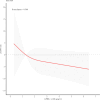Impact of polycyclic aromatic hydrocarbon exposure on thyroid hormone sensitivity: a cross-sectional study of urinary metabolites in 2356 adults from NHANES
- PMID: 40413051
- PMCID: PMC12104898
- DOI: 10.1136/bmjopen-2024-098106
Impact of polycyclic aromatic hydrocarbon exposure on thyroid hormone sensitivity: a cross-sectional study of urinary metabolites in 2356 adults from NHANES
Abstract
Objective: The current study aimed to compare the relationship between polycyclic aromatic hydrocarbons (PAHs) exposure and thyroid hormone (TH) sensitivity markers in individuals with normal thyroid function in the USA population during 2007-2008 and 2009-2012.
Design: Observational cross-sectional study.
Setting: US population data from 2007 to 2008 and 2009 to 2012.
Main outcome measures: Associations between PAH exposure and TH sensitivity were examined, stratified by sex and age, along with dose-response relationships between PAH metabolites and TH sensitivity indices.
Results: In women, after adjusting for confounding variables, 1-hydroxynaphthalene was positively associated with thyroid feedback quantile index of FT4 (TFQIFT4) (β=0.0072, 95% CI 0.0018 to 0.0127, p=0.022), thyrotropin thyroxine resistance index (TT4RI) (β=0.0099, 95% CI 0.0024 to 0.0173, p=0.021) and thyroid-stimulating hormone index (TSHI) (β=0.0107, 95% CI 0.0038 to 0.0176, p=0.012). Among individuals aged 60 years and older, 1-hydroxyphenanthrene was negatively associated with free triiodothyronine/free thyroxine (FT3/FT4) (β = -0.9328, 95% CI -1.5055 to -0.3602, p=0.014). Dose-response analysis revealed no nonlinear relationships between PAH metabolites and TH sensitivity indices in women or individuals aged 60 years and older. Weighted quantile regression analysis demonstrated that OH-PAHs exerted a statistically significant effect (p<0.05) on TH sensitivity indices, including TFQIFT4, thyroid feedback quantile index of FT3, TT4RI, hyrotropin triiodothyronine resistance index and TSHI.
Conclusions: In the US population with normal thyroid function, PAH exposure may interfere with TH sensitivity, with effects varying by population characteristics.
Keywords: Cross-Sectional Studies; Public health; Thyroid disease.
© Author(s) (or their employer(s)) 2025. Re-use permitted under CC BY-NC. No commercial re-use. See rights and permissions. Published by BMJ Group.
Conflict of interest statement
Competing interests: None declared.
Figures




References
Publication types
MeSH terms
Substances
LinkOut - more resources
Full Text Sources
